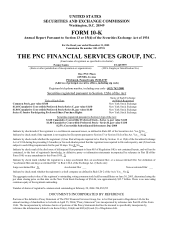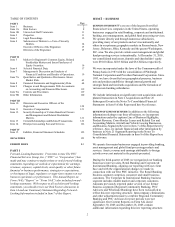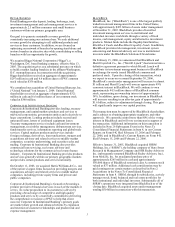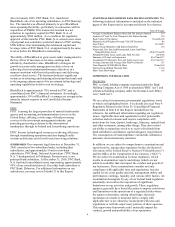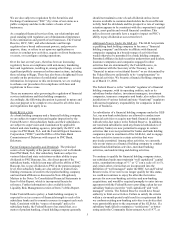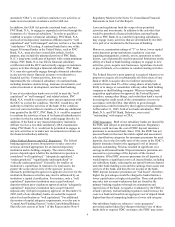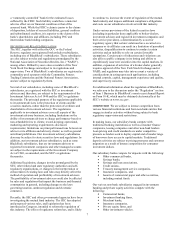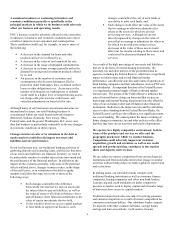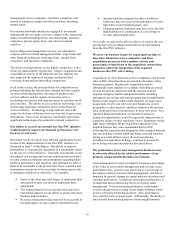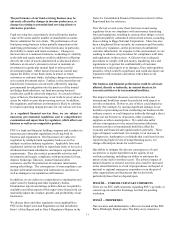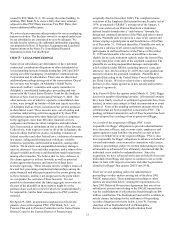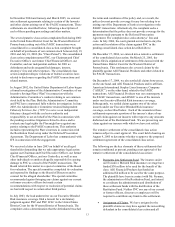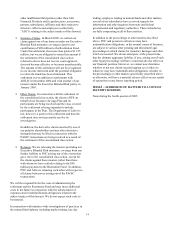PNC Bank 2005 Annual Report Download - page 4
Download and view the complete annual report
Please find page 4 of the 2005 PNC Bank annual report below. You can navigate through the pages in the report by either clicking on the pages listed below, or by using the keyword search tool below to find specific information within the annual report.
4
Also in January 2005, PNC Bank, N.A. transferred
BlackRock, one of its operating subsidiaries, to PNC Bancorp,
Inc. The transfer was effected primarily to give BlackRock
more operating flexibility, particularly in connection with its
acquisition of SSRM. This transaction resulted in a net
reduction in regulatory capital for PNC Bank, N.A. of
approximately $500 million. As a condition for regulatory
approval of this transfer, PNC Bank, N.A. issued a new series
of perpetual non-cumulative preferred shares to PNC totaling
$500 million, thus maintaining the risk-based capital and
leverage ratios of PNC Bank, N.A. at approximately the same
level as before the BlackRock restructuring.
The ability of BlackRock to grow assets under management is
the key driver of increases in revenue, earnings and,
ultimately, shareholder value. BlackRock’ s strategies for
growth in assets under management include a focus on
achieving client investment performance objectives in a
manner consistent with their risk preferences and delivering
excellent client service. The business dedicates significant
resources to attracting and retaining talented professionals and
to the ongoing enhancement of its investment technology and
operating capabilities to deliver on its strategy.
BlackRock is approximately 70% owned by PNC and is
consolidated into PNC’ s financial statements. Accordingly,
approximately 30% of BlackRock’ s earnings are recognized as
minority interest expense in our Consolidated Income
Statement.
PFPC
PFPC is among the largest providers of mutual fund transfer
agency and accounting and administration services in the
United States, offering a wide range of fund processing
services to the investment management industry, and
providing processing solutions to the international
marketplace through its Ireland and Luxembourg operations.
PFPC focuses technological resources on driving efficiency
through streamlining operations and developing flexible
systems architecture and client-focused servicing solutions.
SUBSIDIARIES Our corporate legal structure at December 31,
2005 consisted of two subsidiary banks, including their
subsidiaries, and approximately 90 active non-bank
subsidiaries. PNC Bank, National Association (“PNC Bank,
N.A.”) headquartered in Pittsburgh, Pennsylvania, is our
principal bank subsidiary. At December 31, 2005, PNC Bank,
N.A. had total consolidated assets representing approximately
90% of our consolidated assets. Our other bank subsidiary is
PNC Bank, Delaware. For additional information on our
subsidiaries, you may review Exhibit 21 to this Report.
STATISTICAL DISCLOSURE BY BANK HOLDING COMPANIES The
following statistical information is included on the indicated
pages of this Report and is incorporated herein by reference:
Form 10-K page
Average Consolidated Balance Sheet And Net Interest Analysis 115
Analysis Of Year-To-Year Changes In Net Interest Income 114
Book Values Of Securities 28 and 84-85
Maturities And Weighted-Average Yield Of Securities 86
Loan Types 26 and 87
Selected Loan Maturities And Interest Sensitivity 118
Nonaccrual, Past Due And Restructured Loans And Other
Nonperforming Assets
45,46,72 and 89
Potential Problem Loans And Loans Held For Sale 28,45,46
Summary Of Loan Loss Experience 46-47 and 117
Assignment Of Allowance For Loan And Lease Losses 46-47 and 117
Average Amount And Average Rate Paid On Deposits 115
Time Deposits Of $100,000 Or More 92 and 118
Selected Consolidated Financial Data 17-18
Short -Term Borrowings 118
SUPERVISION AND REGULATION
OVERVIEW
PNC is a bank holding company registered under the Bank
Holding Company Act of 1956 as amended (“BHC Act”) and
a financial holding company under the Gramm-Leach-Bliley
Act (“GLB Act”).
We are subject to numerous governmental regulations, some
of which are highlighted below. You should also read Note 4
Regulatory Matters in the Notes To Consolidated Financial
Statements in Item 8 of this Report, included here for
reference, for additional information regarding our regulatory
issues. Applicable laws and regulations restrict permissible
activities and investments and require compliance with
protections for loan, deposit, brokerage, fiduciary, mutual fund
and other customers, among other things. They also restrict
our ability to repurchase stock or to receive dividends from
bank subsidiaries and impose capital adequacy requirements.
The consequences of noncompliance can include substantial
monetary and nonmonetary sanctions.
In addition, we are subject to comprehensive examination and
supervision by, among other regulatory bodies, the Board of
Governors of the Federal Reserve System (“Federal Reserve”)
and the Office of the Comptroller of the Currency (“OCC”).
We are subject to examination by these regulators, which
results in examination reports and ratings (which are not
publicly available) that can impact the conduct and growth of
our businesses. These examinations consider not only
compliance with applicable laws and regulations, but also
capital levels, asset quality and risk, management ability and
performance, earnings, liquidity, and various other factors. An
examination downgrade by any of our federal bank regulators
potentially can result in the imposition of significant
limitations on our activities and growth. These regulatory
agencies generally have broad discretion to impose restrictions
and limitations on the operations of a regulated entity where
the agencies determine, among other things, that such
operations are unsafe or unsound, fail to comply with
applicable law or are otherwise inconsistent with laws and
regulations or with the supervisory policies of these agencies.
This supervisory framework could materially impact the
conduct, growth and profitability of our operations.

